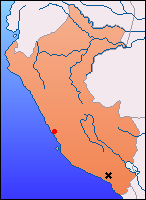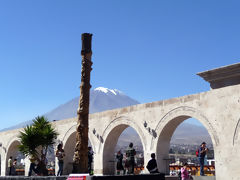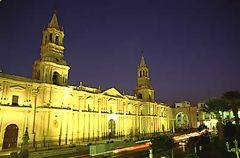 |
Related pages: |
 The department of Arequipa boasts an impressive historical legacy, dating back 5,000 years BC, as evidenced by over 400 archaeological rock art sites that have been documented to date. These pre-Columbian remains remind us that the region of Arequipa was inhabited by ancient civilizations long before the arrival of the Incas.
The department of Arequipa boasts an impressive historical legacy, dating back 5,000 years BC, as evidenced by over 400 archaeological rock art sites that have been documented to date. These pre-Columbian remains remind us that the region of Arequipa was inhabited by ancient civilizations long before the arrival of the Incas.
When the Incas arrived in the Colca Valley, they encountered two established ethnic groups: the Collaguas and the Cabanas. The Incas integrated these people into their empire and transformed this region into one of the most prosperous agricultural hubs of the Inca Empire. The magnificent terraces, still visible today, are a testament to the colossal agricultural work accomplished by these peoples under Inca rule.
The Villa Hermosa of Arequipa was founded in 1540 in the old district of San Lázaro by Spanish settlers. Arequipa quickly became an important city, not only due to its strategic location between the coast and The Andes but also because of its role in the silver trade route connecting Potosi to Spain. Its enlightened bourgeoisie provided Peru with some of its most influential leaders, who shaped the country’s political and cultural history.
 Situated in a seismic zone, the city of Arequipa has been partially destroyed several times throughout its history. This has shaped its characteristic architecture: thick walls supported by large buttresses, low domes, and limited use of wood in major structures. These adaptations allowed the city to rebuild after each natural disaster while preserving its colonial charm.
Situated in a seismic zone, the city of Arequipa has been partially destroyed several times throughout its history. This has shaped its characteristic architecture: thick walls supported by large buttresses, low domes, and limited use of wood in major structures. These adaptations allowed the city to rebuild after each natural disaster while preserving its colonial charm.
Arequipa is also known as the "white city" due to its buildings made from white volcanic stone called sillar. This material comes from the petrified volcanic ash of the Chachani volcano, adding a unique touch to the urban landscape. The city is located at the foot of the majestic Misti, a dormant volcano that dominates the region at 5,821 meters high.
Arequipa is a perfect city for walking. Its streets offer numerous unusual architectural details, such as banks housed in old colonial mansions, casonas, churches, and convents. The colonial facades, with their wrought-iron balconies and shady patios, showcase the city's rich colonial heritage.
Today, Arequipa is one of the most dynamic cities in Peru. Its historical role in the silver trade, strengthened by the construction of the railway in 1870, which linked the Altiplano to the port of Mollendo, made it a key crossroads. In addition to its thriving economy, it attracts thousands of visitors every year who come to discover its architectural treasures and unique culture.